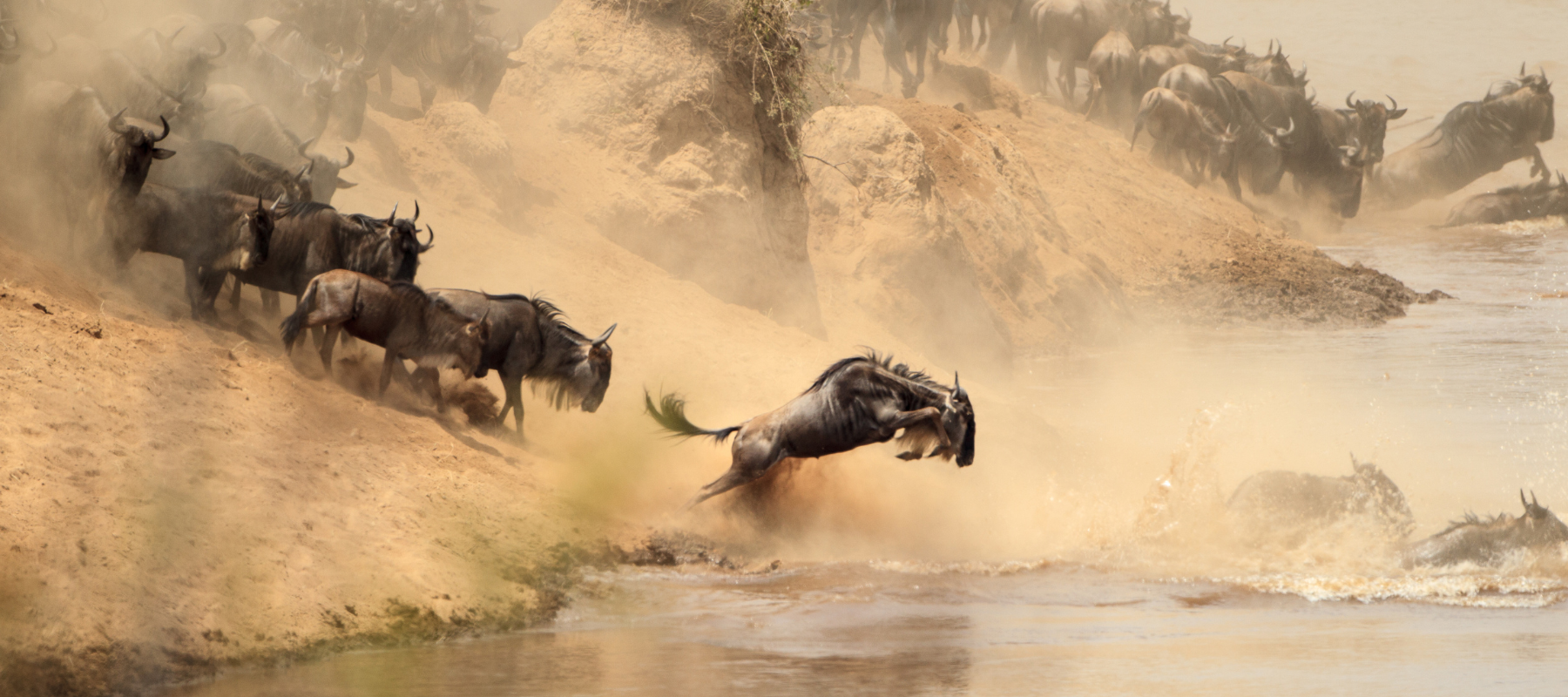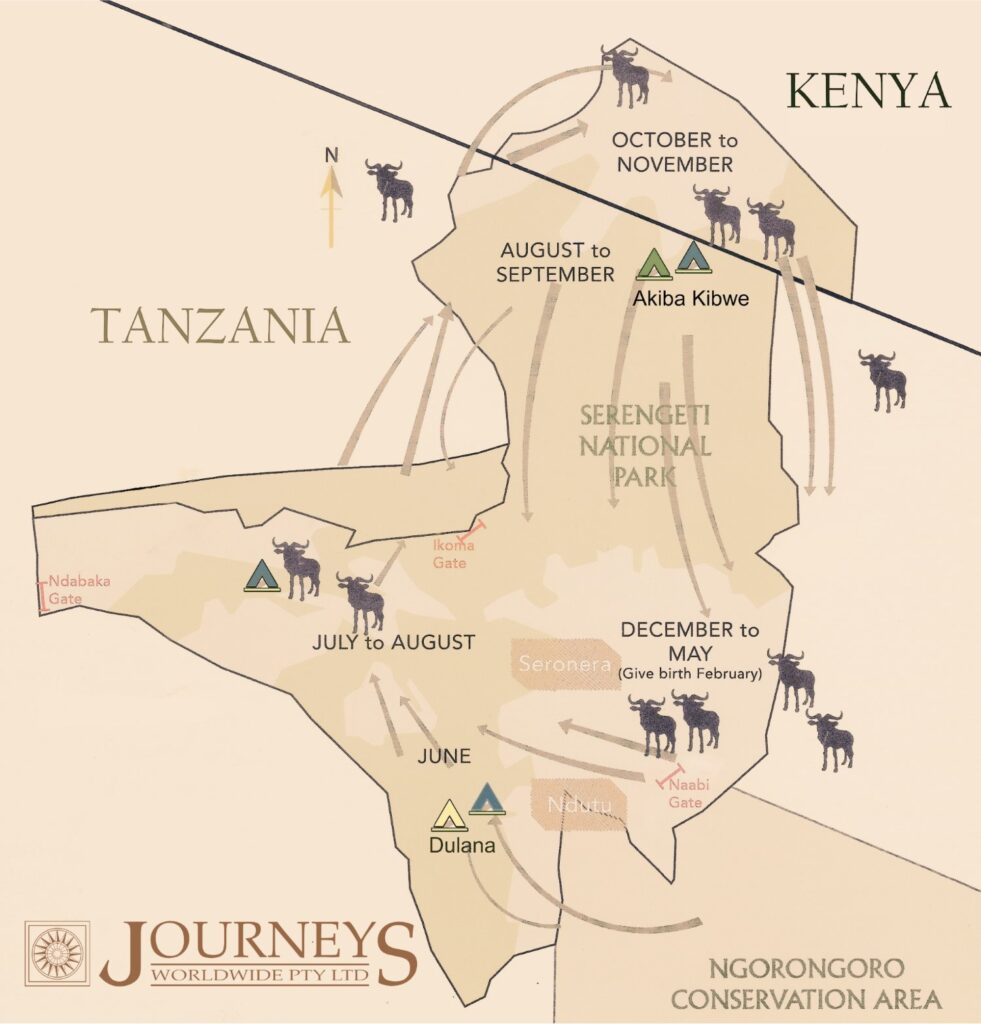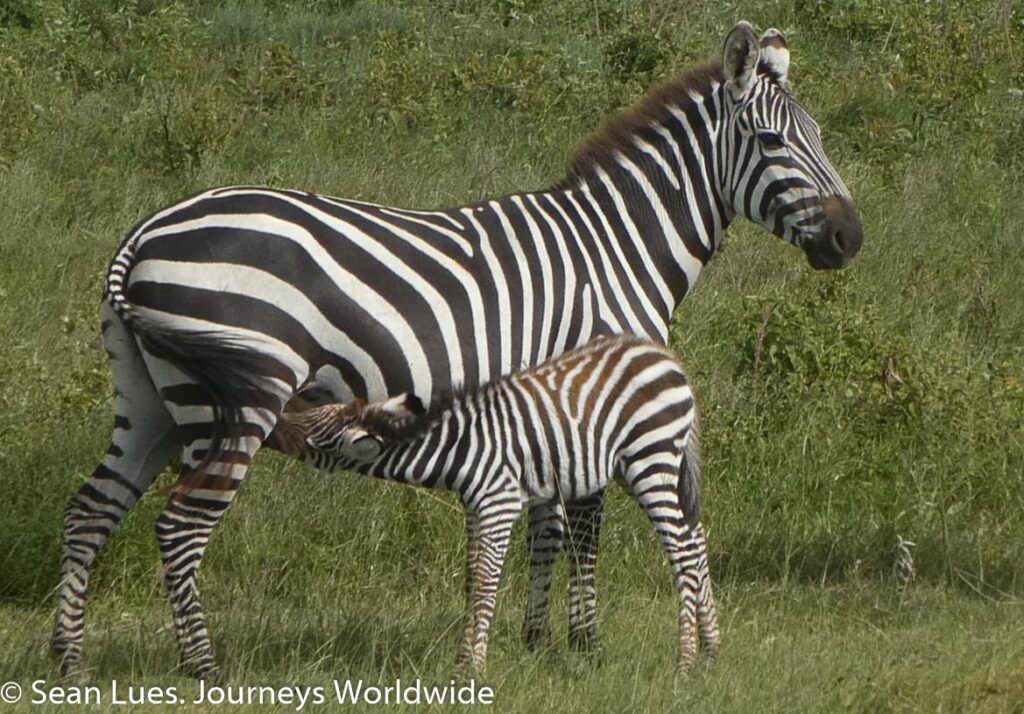
The Great Migration
Article by Sean Lues at Journeys Worldwide
The Serengeti is a vast expanse of grassland and savannah stretching across Tanzania and Kenya in East Africa. It is home to one of the most incredible wildlife spectacles on the planet – the Great Migration. This event sees millions of wildebeest, zebra, gazelle and other animals embark on a perilous journey in search of greener pastures. Spanning over 800 kilometres, this natural phenomenon is truly awe-inspiring and definitely the spectacle of a lifetime.
About the Great Migration
The Great Migration is a continuous cycle that has been happening for centuries. It is driven by the animals’ search for food and water as the seasons change. The Serengeti experiences two main seasons – the dry season and the wet season. During the dry season, the land becomes parched and food becomes scarce. The wildebeest, zebra and other herbivores are forced to move in search of greener grass and water sources.
It is estimated that more than 1.5 million wildebeest, 500,000 gazelle and 200,000 zebra, amongst other animals, make up the Great Migration. This enormous number of animals moving in unison creates a truly mesmerizing event. As they traverse the Serengeti, they face numerous challenges, including predators, treacherous river crossings, and exhaustion.
We start to follow their journey in the southern Serengeti, where the herds spread out across the short grass plain to give birth to their young. Hundreds of thousands of young calves are mostly born during a period of about two to three weeks between the short rainy season(vuli), generally falling between November and January and the long/heavy rains (Masika), generally falling between March and May. This is my favourite time of the year in the Serengeti! The flat endless plains don’t have rivers, but the rainwater has collected in shallow pans, allowing a water source for the huge numbers of the migration. The shallow volcanic soils bear nutritious grasses for the vast herds and a little cover for the sudden glut of babies being born, but not much cover for the predators, who are there in abundance as well!
As the dry season approaches, the herds start their epic migration towards the north, following the rains for the fresh grazing opportunities and the permanent water in the rivers.
One of the most thrilling and dangerous aspects of the migration is the river crossings and this is what most think the migration is all about – as these make for incredible footage in the documentaries. The Grumeti River in the north-west and the Mara River, located at the northern end of the Serengeti, presents a formidable obstacle for the migrating herds. As they gather at the river’s edge, they hesitate, sensing the lurking danger below the water’s surface. Crocodiles lay in wait, ready to seize their opportunity to feast on the unsuspecting animals.

The river crossing is a nerve-wracking spectacle, attracting both tourists and predators. Lions, hyena and cheetah take advantage of the chaos, picking off weak or injured animals as they clamber out of the river crossings, or as they huddle together, pushing each other towards the river’s edge to make the crossing. It is truly survival of the fittest, where only the strongest and luckiest make it.

The Serengeti Migration is not only monumental in terms of scale but also in its ecological impact. The migration plays a crucial role in maintaining the delicate balance of the Serengeti ecosystem. Generally, the zebra are at the forefront – equipped with both upper and lower incisor teeth, they are able to bite off the taller, tougher grasses. Their stomachs are also adapted to dealing with this grass which has a lower nutritional value and they therefore ‘bulk-feed’, extracting what little nutrition there is from large amounts of food. The wildebeest follow. With only lower incisor teeth, they pluck the fresh shorter grasses. Their 4 chambered stomachs allow them to ruminate, extracting much more from these more nutritious grasses.
This pattern of grazing and movement prevents overgrazing in one area, allowing the land to recover and regrow.
The Serengeti Migration is truly a once-in-a-lifetime experience. It showcases the beauty, power, and resilience of nature. The sight of thousands upon thousands of animals moving together in harmony to ensure their survival is a humbling and awe-inspiring spectacle. It is a testament to the adaptability and instinctual knowledge that these animals possess.
When & where to see the Great Migration
December – March
- Easily accessible from Arusha and Ngorongoro.
- From late January through February this region witnesses a birthing period where wildebeest deliver thousands of calves daily. Whilst there are thousands of babies being born daily, it all happens so quickly and it can be easy to miss. Witnessing the awe-inspiring sight of wildebeest giving birth amidst the abundant young is a unique experience.
- Classic Serengeti scenes with endless plains.
- Beautiful and green
- Muddy Conditions: The rainy season brings muddy tracks and grassy landscapes, which can hinder access to some areas, limit visibility, and potentially make game drives more challenging.
April – May
- Having given birth and having feasted on the nutritious grasses of the southern Serengeti, the migration starts to make its way north again.
- A large portion of the herd are within the woodlands of the western Serengeti, where there are few tracks and it is not easy to find them.
- The end of the long rainy season, it is muddier and more vegetation means animals are not so easy to find, but the environment is greener and more beautiful.
- Fantastic birding, with many migrants pausing here on their way back north again.
June – July
- The herds move through the Western Corridor and the young encounter their first major obstacle – the Grumeti River.
- Generally these crossings are much less crowded by tourists.
- Herds can wait up to two weeks on the southern bank before making the crossing.

August – September
- Witnessing River Crossings: Traveling during this period offers a high chance to witness dramatic river crossings, where throngs of wildebeest and zebra risk their lives to ford the Mara River, sometimes crossing back forwards on a number of occasions between the Serengeti in Tanzania and the Maasai Mara in Kenya. This spectacle of survival is a highlight for many visitors.
- Abundance of Predators: In pursuit of the migrating herds, large predators such as lion, cheetah and hyaena wait in ambush on the riverbanks, increasing your likelihood of witnessing extraordinary hunting scenes.
- Spectacular Landscapes: The dry season unveils a picturesque panorama with golden plains dotted by large herds, providing stunning photo opportunities alongside Africa’s most famous wildlife.
- Crowded Parks and Accommodation: The high season attracts a considerable number of tourists and safari vehicles, which can detract from the sense of wilderness and create congestion in popular areas.
- Higher Prices: Demand during the high season causes a surge in prices for accommodation, tours, and flights, making it a more expensive time to see the Great Migration.
- Dusty: The post-rain season sees the landscape gradually change to dry savannah, lacking the lush greenery that some visitors may desire for their wildlife encounters.
- Groups can spend many uneventful hours, even days, waiting at river crossings and the herds may or may not cross.

October – November
- You may still witness some river crossings in early October.
- Avoiding Crowds: Traveling outside peak season grants the opportunity to experience the vastness of the Serengeti in a more intimate setting, with fewer tourists around, making for an exclusive encounter with nature.
- Lower Prices: Accommodation prices tend to drop significantly during the low season.
- Unpredictable Migration Patterns: During the off-peak season, the herds disperse across the vast plains, making their precise location less predictable, requiring expert guidance and patience to locate them.
The Great Migration is an extraordinary event that unfolds year-round, each season presenting unique advantages and challenges. The decision on when to visit should consider personal preferences, interests and budget. For those who crave the best chance of witnessing a dramatic river crossing and action-packed predator sightings, the high season (July to September) offers unparalleled opportunities. On the other hand, the low season (October to June) promises a more serene and exclusive experience, with lower prices and possible magical moments of witnessing a wild animal giving birth.
Whichever season you choose, the Great Serengeti Migration promises a once-in-a-lifetime adventure, forever etching the raw power, resilience and unyielding movement of nature’s magnificent creatures into your memory. It is an experience that will leave an indelible mark on your soul and remind you of the incredible wonders that this world has to offer.
So, pack your binoculars, ready your camera and embark on an unforgettable journey to witness this breathtaking phenomenon amidst the dramatic landscapes and vibrant wildlife of the Serengeti National Park!
Keen to see the Great Migration for yourself? Why not check out our ‘Great Migration Safari‘ luxury tour in conjunction with our friends at Journeys Worldwide and led by expert safari guide Sean Leus.


Leave a Reply